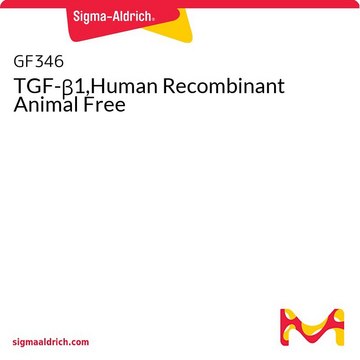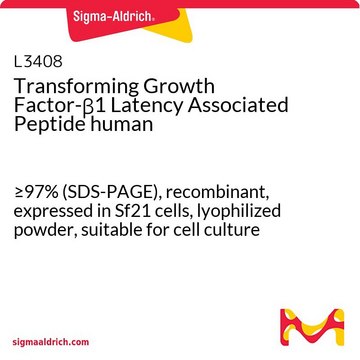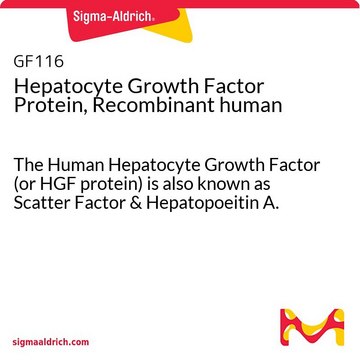11412272001
Roche
Transforming Growth Factor-β1, human (hTGF-β1)
recombinant (CHO cells)
Synonym(s):
hTGF
Sign Into View Organizational & Contract Pricing
All Photos(1)
About This Item
UNSPSC Code:
12352207
Recommended Products
biological source
human
Quality Level
recombinant
expressed in CHO cells
Assay
>95% (SDS-PAGE)
form
solution
potency
<0.1 ng/mL EC50
mol wt
25,000 Da
packaging
pkg of 1 mL (1 μg)
manufacturer/tradename
Roche
storage condition
avoid repeated freeze/thaw cycles
impurities
<0.1 EU/μgtested (LAL test)
UniProt accession no.
storage temp.
−20°C
Gene Information
human ... TGFB1(7040)
General description
Recombinant, human TGF- β1 is produced in CHO (Chinese Hamster Ovary) cells and purified by standard chromatographic techniques.
Solution in PBS and 1 mg/ml BSA, filtered through 0.2 μm pore size membrane.
Solution in PBS and 1 mg/ml BSA, filtered through 0.2 μm pore size membrane.
Specificity
Species specificity: Transforming growth factor-β1 (TGF-β1) is effective on human and mouse cells.
Specific activity/EC50: <0.1 ng/ml, at least the same specific activity (EC<SUB>50) compared to the indicated standard is guaranteed.
Specific activity/EC50: <0.1 ng/ml, at least the same specific activity (EC<SUB>50) compared to the indicated standard is guaranteed.
Application
Transforming growth factor-β1, human (hTGF-β1) has been used to explore function and underlying mechanism of periostin (PN) during orthodontic periodontal ligament remodeling.
Biochem/physiol Actions
Transforming Growth Factor-β1, human (hTGF-β1), is a multifunctional growth factor affecting many functions in a variety of different cells.
Transforming growth factor-β (TGF-β) family comprises of a group of multifunctional cytokines which are involved in controlling apoptosis, growth and differentiation of cells, and play important role during embryo development.
Quality
Purity: >95% (SDS-PAGE)
Endotoxin level: <0.1 EU/μg (LAL-test), <10 EU/ml (LAL-test)
(Note: 1 EU corresponds to 0.1 ng)
Endotoxin level: <0.1 EU/μg (LAL-test), <10 EU/ml (LAL-test)
(Note: 1 EU corresponds to 0.1 ng)
Sequence
Chain Length 2 x 112 AA
Two identical polypeptide chains (112 amino acids) connected by disulfide bridges, identical to natural hTGF-β1.
Unit Definition
EC50 definition: The concentration of hTGF-β1 that is required to mediate half maximal inhibition of DNA synthesis (BrdU incorporation) with Mv1-Lu cells.
Preparation Note
Working concentration: 0.01 - 10 ng/ml
Recombinant, human TGF-β 1 exerts its biological activity in the concentration range of 0.01–10 ng/ml.
Working solution: Dilute the concentrated TGF-β1 solution (1 μg/ml) with PBS or culture medium containing BSA [or HSA (human serum albumin)], 1 mg/ml (0.1%) or serum 1–10%.
Storage conditions (working solution): For best results, prepare appropriate aliquots and store at -15 to -25 °C.
Note: Avoid repeated freezing and thawing.
Recombinant, human TGF-β 1 exerts its biological activity in the concentration range of 0.01–10 ng/ml.
Working solution: Dilute the concentrated TGF-β1 solution (1 μg/ml) with PBS or culture medium containing BSA [or HSA (human serum albumin)], 1 mg/ml (0.1%) or serum 1–10%.
Storage conditions (working solution): For best results, prepare appropriate aliquots and store at -15 to -25 °C.
Note: Avoid repeated freezing and thawing.
Other Notes
For life science research only. Not for use in diagnostic procedures.
Storage Class Code
12 - Non Combustible Liquids
WGK
nwg
Flash Point(F)
does not flash
Flash Point(C)
does not flash
Regulatory Information
新产品
Choose from one of the most recent versions:
Already Own This Product?
Find documentation for the products that you have recently purchased in the Document Library.
Periostin is essential for periodontal ligament remodeling during orthodontic treatment.
Xu HY, et al.
Molecular Medicine Reports, 15(4), 1800-1806 (2017)
α-MSH stimulation contributes to TGF-β1 production via MC1R-MITF signaling pathway in melanoma cell
Hayashi E, et al.
Inflammation and regeneration, 35(5), 244-254 (2015)
Cloning, expression, and characterization of chicken transforming growth factor ?4
Pan, Hongjie, and Jaroslava Halper
Biochemical and Biophysical Research Communications, 24-30 (2003)
Barbara Chiavarina et al.
Theranostics, 11(4), 1626-1640 (2021-01-08)
Colorectal cancer (CRC) cells are traditionally considered unresponsive to TGFβ due to mutations in the receptors and/or downstream signaling molecules. TGFβ influences CRC cells only indirectly via stromal cells, such as cancer-associated fibroblasts. However, CRC cell ability to directly respond
Articles
Role of growth factors in stem cell differentiation and various growth factors for your research at sigmaaldrich.com
Our team of scientists has experience in all areas of research including Life Science, Material Science, Chemical Synthesis, Chromatography, Analytical and many others.
Contact Technical Service




